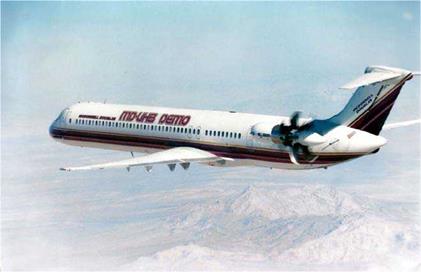Propfans
In 1975, Hamilton Standard introduced a proof of concept advanced turboprop engine designed for short to medium haul airliners. The new engine was designed to power a propeller of advanced design, with five to thirteen sweptback, scimitar shaped blades. In 1976, NASA’s Lewis Research Center in Cleveland, Ohio, contracted to Hamilton Standard to jointly research and developed an advanced turboprop engine driving a propeller with eight titanium blades to be efficient at the aircraft’s cruise speed of Mach 0.8. Titanium was chosen because metal blades are too thick and therefore inefficient at the transonic speeds (Mach 0.8 to 1.2) the propeller was designed to run at. This propeller became known as the Propfan, a term now generally used to describe such propellers.
NASA later joined forces with General Electric (manufacturers of jet engines) to produce a Propfan using composite blades for their strength and light weight. General Electric copyrighted the name of their Propfan an ‘Unducted Fan (UDF). The first flight of the GE-36 UDF occurred on 20 August 1986 at Edwards Air Force Base, California, and testing ended in February 1987. The engine was attached to the right – hand engine mount of a Boeing 727-100 test plane and was the first Propfan to become airborne. The unducted, pusher Propfan had an eight-blade contra-rotating propeller of 11 feet (3.35 m) diameter.
General Electric also flight-tested a Propfan on a McDonnell Douglas MD-80 between May 1987 and March 1988. This Propfan also had eight scimitar shaped contra-rotating blades, driven by the GE turbine engine with an un-geared, direct drive, unducted fan. This resulted in a greatly improved performance over a conventional jet engine. McDonnell Douglas named their Propfan a UHB (Ultra-high By-pass ratio engine) with scimitar blades. It had a by-pass ratio of 36:1, compared to 5:1 ratio of a Boeing 747’s JT5D engines. After four years of research and development at a total cost of around $100 million, McDonnell Douglas cancelled the project due to the high cost of the engine.
Pratt & Whitney joined forces with Allison to jointly test the P&W Allison Model 578-DX 20,000 static-pound thrust turboprop with a Hamilton Standard six-blade contra-Propfan of 11 feet 7 inches (3.53 m). The first flight of the MD-80 with the geared Propfan occurred on 13 April 1989, with all testing completed in a few weeks.
The extent of this author’s research shows the big American companies are no longer involved in any Propfan research for several years now. In the Commonwealth of Independent States (formerly Russia) research continued for a longer period. An Ilyushin IL-76 test-bed aircraft was used to test the Lotarev
|
The McDonnell Douglas MD-80 flight-testing the P &W Allison Model 578-DX Propfan. Photo courtesy Hamilton Standard, Connecticut, USA. |
contra-rotating tractor Propfan mounted on its number 2, (port inner) engine mount, with the first flight being made on 25 March 1971. The Yak-46, a 168-seat airliner with a pusher Propfan, is powered by two 24,690 pounds thrust ZMDB Progress D-27 Propfan with a first flight conducted circa 1995. The Antonov AN-180 was another type of passenger aircraft on the drawing boards around that time. It was due to fly around 1995 and was powered by two, rear-mounted tractor Propfan engines, the same type as found on the YAK-46.
Other types under test include the Antonov AN-70T designed as a military and civilian large STOL transport with a maximum all-up weight of 286,600 pounds (130,000 kg). It made a first flight on 16 December 1994 but its life was short-lived, due to its loss in a mid-air collision with its Antonov AN-22 chase plane on 10 February 1995. The second prototype first flew on 24 April 1997 with a third aircraft built in 1998. A 14,000 SHP Progress/Motor Sich D-27 turboprop engine drives each of the four, Aerosylva Stupino SV-27 turbine engines drive tractor, contra-rotating Propfans, which are different to the usual Propfan configuration. The fan has eight blades mounted on the front prop and six-blades mounted on the rear prop. Production was planned for this aircraft with 100 units being built for the Ukraine Air Force and 500 for the Russian Air Force, as of 1998. After a prolonged test program lasting sixteen years with many obstacles in its path, production started in 2012 for the Antonov AN-70. This places Russia ahead of the USA in Propfan technology, and with Propfan aircraft in service
Conclusion
The propeller’s development has come a long way since Blanchard first used a propeller on his hot air balloon way back in 1784, to the present day high-technology propellers. Constant-speed props with auto feathering and reverse thrust have been around for several years now and composite props are being used more and more on new aircraft types. Will the Propfan replace the present day turboprop transport aircraft? It may do so one day in Russia, but for the rest of the western world, turboprop aircraft with at least six-blade composite props will be flying for many years to come.












